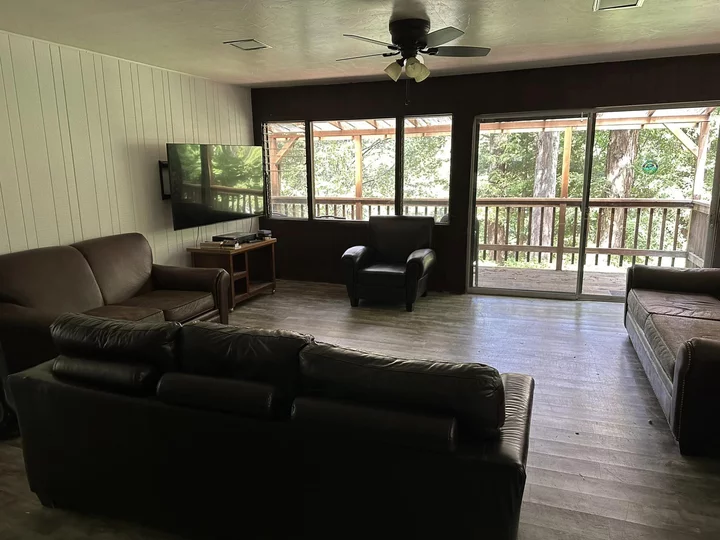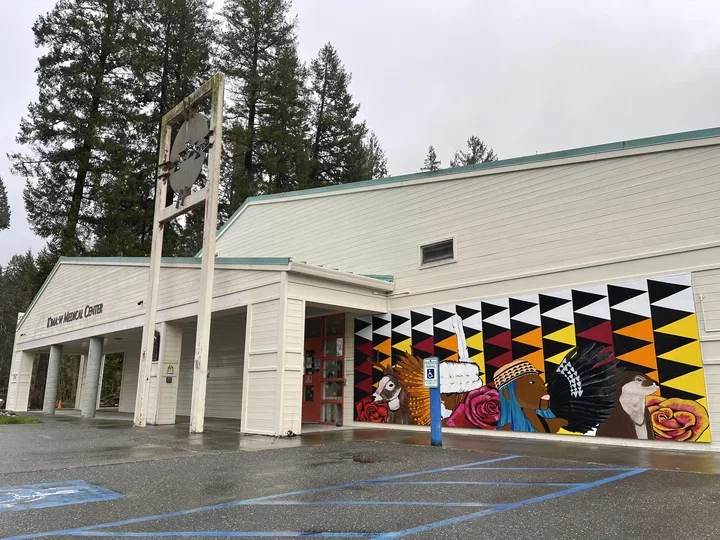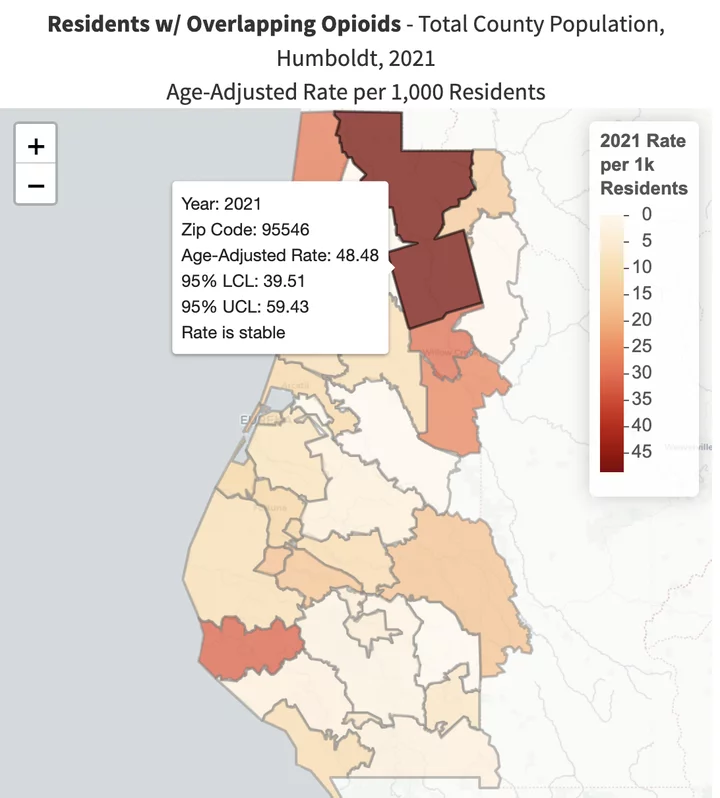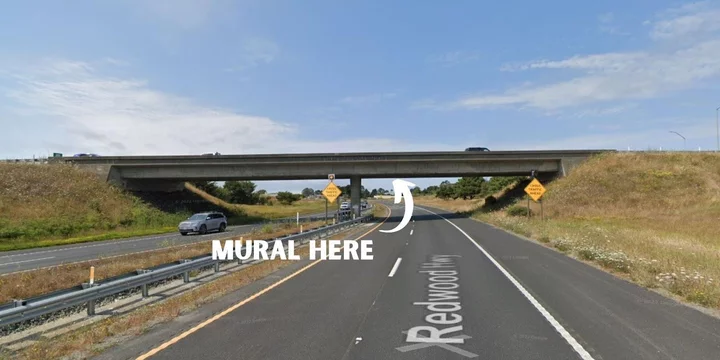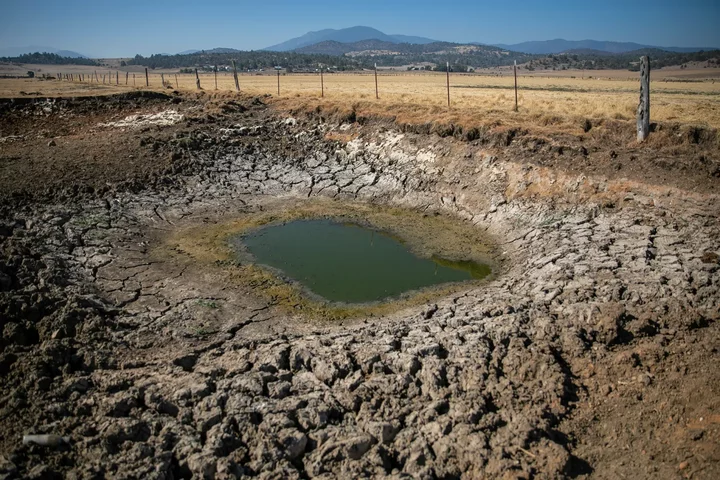After Closing Its Doors Late Last Year, Singing Trees Recovery Center Will Reopen Next Week Under New Ownership
Stephanie McGeary / Friday, June 9, 2023 @ 4:20 p.m. / News
Singing Trees on Highway 101, south of Garberville will reopen Monday! | Images provided by counselor Marilynne Susie Walpole
Many members of the community were saddened to hear the news last November that Singing Trees Recovery Center – which had served as a drug detox and rehabilitation center in Southern Humboldt for more than 30 years – was permanently closing its doors.
Now, after six months of uncertainty about what would happen to the facility, KMUD News recently reported that Singing Trees is set to reopen on Monday, June 12 under the ownership of non-profit Pure Solution Family Services, and will again offer recovery treatment for those in need.
“We’ve gotten so much support from the community and it’s been really amazing,” Courtney Bell, the new manager of Singing Trees, told the Outpost in a phone interview Friday. “The old owners put their lives into it and they’re really happy that it’s reopening.”
Bell said that Pure Solutions took over the property in January, but a few setbacks – including the storms, which caused some damage on the property – have delayed the opening from what was originally scheduled. Currently the company is “leasing to own” the property, Bell said. So, Patti Watson’s family still technically owns the property for now, but Pure Solutions is paying it off and is in charge of all of the maintenance and upkeep.
When interviewed by the Outpost in November, Watson said the two main reasons for the closure were staffing issues and the expensive maintenance of the center’s aging infrastructure. And Bell said that though the owners put in a lot of work to keep the facility operational, there was a lot that had to be done before reopening. Since taking over Singing Trees, the new operators have already replaced the electrical and some of the flooring and completely remodeled the kitchen and the counseling room.
Above and below: Some of the remodeled interior
Some sections of the center – like the famous sweat lodge – were in such bad repair that they had to be temporarily closed. So, Bell said, the sweat lodge will not be open for a while, but the staff is working to get it back up and running eventually. Bell added that the community AA and NA meetings that were held on the weekends will also return to the center eventually, but they will not be held immediately.
As far as the staffing issue, Bell said that this has not been a problem for the new center. Several Pure Solutions staff members, including Bell, have moved over to the recovery center and some of the Singing Trees staff, including chefs and counselors, have been rehired.
In addition to having some of the same staff, Singing Trees will offer many of the same services as before. The center will still hold 20 beds and offer options for two-week, 30-day, 60-day and 90-day rehabilitation programs. In addition to providing group and one-on-one counseling, the center will also implement some of the holistic healing approaches previously offered, such as yoga classes and spending time in nature.
Pure Solution Family Services was started by founder Amber Bedell as a nonprofit that offers wraparound services for adopted children and their families in Humboldt, Mendocino and Butte Counties. Though Pure Solution does not usually focus on recovery from substance abuse, it does focus on mental and behavioral health services, which includes addressing problems with addiction and implements holistic approaches to addressing these issues.
In an interview with KMUD, Bedell said that the taking over Singing Trees was an “amazing universe lineup” and that, after learning that the center had closed, she connected with the owners, who were very supportive of selling the space to someone who planned to reopen it as a recovery center.
Though there will be many of the same services offered at Singing Trees, Bedell also said that the center will not be as focused on 12-Step recovery programs like NA and AA and will offer “a variety of modalities.” The center will still offer 12-Step materials and utilize some of those approaches, Bedell said, but will take bits from other recovery models and tailor a treatment plan to the individual.
“It’s just not a one-size-fits-all, cookie-cutter approach — we believe in co-creation and we believe in empowering people,” Bedell told KMUD. Often people know the best what they need, they just don’t often have access or the ability to talk about it without a guide. So we can be that guide.”
Singing Trees Recovery Center will officially reopen on Monday, June 12. If you are struggling with addiction you can call the center at 707-247-3495.
BOOKED
Today: 12 felonies, 20 misdemeanors, 0 infractions
JUDGED
Humboldt County Superior Court Calendar: Friday, Jan. 9
CHP REPORTS
2542 Quinlan Ave (HM office): Traffic Hazard
Sr255 / V St (HM office): Live or Dead Animal
E Washington Blvd / Summer Ln (HM office): Defective Traffic Signals
ELSEWHERE
Washington Post: A woman’s life among black bears taught her a lot about being human
Washington Post: Trump’s college agenda may have a lasting impact on research, culture
AP News: Iran warns against US strikes as activists say protest death toll reaches 203
The Atlantic: The Most Shouted-At Politician in America
BEHIND the CURTAIN: Kinky Boots at FRT Shows Drag in a New Light, Preaches Message of Individuality and Acceptance
Stephanie McGeary / Friday, June 9, 2023 @ 3:30 p.m. / Theater
The cast of Kinky Boots at Ferndale Repertory Theatre show drag is for everyone | Photos: Stephanie McGeary
###
“Be yourself; everyone else is already taken.” – Oscar Wilde
For actor Virgo Marroquin, better known as their on-stage persona Komboujia, this one line, which is quoted by her character in Kinky Boots, perfectly embodies the overarching theme of the musical and the spirit of drag in general – that being your authentic self is crucial, no matter what others might think or say.
“Our characters are all about ‘this is who I am and I need acceptance. I require it,’” Komboujia told the Outpost in an interview backstage at Ferndale Repertory Theatre, just before the final dress rehearsal of Kinky Boots. “It really drives home the fact that being who you are and having people who recognize that and nourish that is not optional.”
Komboujia plays the starring role of Lola, a fabulous and self-assertive drag queen who, after a chance meeting with somewhat straight-laced shoemaker Charlie, ends up helping him save his father’s shoe factory by designing a line of high-heeled boots for drag queens. As the two work together they learn that they have more in common than they realized, especially that they both had expectations forced onto them that don’t fit who they really are. The musical (book written by Harvey Fierstein and music/lyrics written by the legendary Cyndi Lauper) is adapted from the 2005 film of the same name, written by Geoff Deane and Tim Firth and based on a true story.
This is Komboujia’s first time performing at FRT and the first time they’ve been in a musical since high school. As a prominent local drag artist and lead singer of local rock band Vegan Slaughterhouse, they are plenty comfortable on the stage. But being in this type of show, Komboujia said, is still a daunting task. There is so much involved in doing a musical – months of rehearsals, memorizing lines and group choreography, on top of performing the show three nights a week under the scorching stage lights – and it’s a lot to take in.
And though playing the part of a drag queen seems perfect for a drag performer, Komboujia said that some aspects of embodying the role of Lola has been a challenge, especially since this is not a role that “someone like me traditionally plays,” they said.
In the film and musical Lola’s character is written as and traditionally played by a Black man (Chiwetel Ejiofor played Lola in the film and Billy Porter, Todrick Hall and Wayne Brady have all played the character on Broadway). As a Latinx person, Komboujia said they were a little concerned about taking a role that may be better suited for someone else in the community. But after a bit of convincing, they decided to accept the challenge and worked with the director, Tiggerbouncer Custodio, to find ways to represent Komboujia’s identity, while still staying true to the character and the story. This required some slight changes to the script, to make Lola’s story cohesive. There are, for example, several lines where Lola or other characters speak in Spanish.
Komboujia is also trans and non-binary and brings an element of that into Lola’s character. “I went in a different direction to represent a character who I don’t usually see represented in musicals – because I’m trans and non-binary,” they said.
The show also features an ensemble of other local drag performers, including Glitterous Clitterous (billed as Glit Clit) and Cocky Muffington (Roux Kratt), who, along with actors Rigel Schmitt and Izzy Ferraro, play Lola’s drag entourage “the Angels.” The fabulous cast – which also includes William English III (Charlie), Elaine Yslas (Pat), Valerie Rose (Trish), Miah Carter (Harriet), Jessy McQuade (Nicola), Rocky Kratt (Don), Samahri Brice (Lauren), Brad Harder (George) and ensemble members Amethyst Shelton and Ash Quintana – bring tons of personality and joy to the show. And child actors Korbin Campbell (young Charlie) and Ziomara Paz Dominguez (young Lola/ Simon) are absolutely delightful.
Because Kinky Boots centers around drag, there is a lot of focus on the costumes in this show (Komboujia alone has about 10 costume changes) and designer Olivia Gambino told the Outpost it was very important to her to bring an extra level of polish, glitz and glamor to the FRT stage. Gambino – who also does burlesque with local troupe Va Va Voom – has a lot of experience designing her own costumes and said when Custodio asked her to help with this show, she leapt at the opportunity.
“I poured my heart and my soul into it and I really feel like I worked hard to make sure [the performers’] individuality shone,” Gambino said, as she was busy fixing rhinestone jewelry backstage. “We have three major local drag performers in this show and it was so important to me to say ‘I don’t want them to look like anybody else.’ I want them to be themselves out on that stage.. That’s what it’s all about. It’s all about being yourself.”
Gambino, with help from actor Roux Kratt who also assisted with costumes, brought a lot of items from her own closet and used some things provided by the drag performers in the show too, and added as much extra flare to the pieces as possible. Gambino and Kratt spent hours and hours painstakingly rhinestoning wigs and boots. Gambino said that the famous “kinky boots” – red patent leather thigh-highs, worn by both Lola and Charlie in the finale – took 14 hours per boot to rhinestone.
But Gambino said that putting in all that time is worth it for her, because she loves helping her friends and gets to spend time with incredible people while she works on this show. Plus she loves local theater and being a part of a show that spreads such an important message during a time when it is really needed. “I feel that this positive message of both individuality and acceptance in the community is really important,” she said.
And Komboujia whole-heartedly agrees that, especially during Pride Month and in a time when drag and the LGBTQ+ community are facing extreme backlash, both locally and around the country, that showcasing drag in a musical and the themes in Kinky Boots – love, acceptance, being yourself and not accepting the “role” that was assigned to you – are more important now than ever.
“I think it is important for people to see that there is an alternative and that there are people out here who are supportive of living authentically and not having to make concessions about who you are,” Komboujia said. “This show does a really great job of showing two people who are not from the same experience shake hands over the line, which I find really beautiful.”
You can catch Kinky Boots at Ferndale Repertory Theatre Fridays and Saturdays at 8 p.m. and Sundays at 2 p.m. through July 2. Click here for tickets.
The angels dazzle the stage. From left: Rigel Schmitt, Izzy Ferraro, Komboujia, Roux Kratt, Glit Clit (English on the floor)
U.S. Fish and Wildlife to Reconsider Whether West Coast Fishers Warrant Endangered Species Act Protection
LoCO Staff / Friday, June 9, 2023 @ 2:44 p.m. / Wildlife
Closeup of a fisher in a forest. | John Jacobson, Washington Department of Fish and Wildlife.
###
Press release from the Center for Biological Diversity, the Klamath Siskiyou Wildlands Center and EPIC:
SAN FRANCISCO— In a legal victory, the U.S. Fish and Wildlife Service today agreed to reconsider whether West Coast fishers in northern California and southern Oregon warrant protection under the Endangered Species Act.
Fishers are relatives of mink, otters and wolverines, and live in old-growth forests. The Service has until Aug. 21, 2025, to decide whether to protect them.
“It’s great news that the Service is reconsidering its refusal to protect the elusive Pacific fisher, but waiting more than two decades to provide these protections is indefensible,” said Brian Segee, endangered species legal director at the Center for Biological Diversity.
“These fierce, plush-furred forest weasels have few natural predators, but they’re no match for people logging and poisoning their old-growth habitat. Protecting them under the Endangered Species Act is more important now than ever.”
Organizations first petitioned the Service to grant West Coast fishers endangered species protection in 2000, leading to a 2004 determination by the agency that the fisher should be listed as threatened throughout its West Coast range. But rather than provide this protection the Service delayed, arguing there was a lack of resources.
The agency annually reaffirmed the fisher’s imperilment for more than a decade until 2016, when it abruptly reversed course and denied protection. After the groups successfully challenged that decision, in 2020 the Service granted protections to fishers in the southern Sierra Nevada but nowhere else. The current lawsuit challenges the denial of protections in the rest of the fisher’s habitat.
“This is our last, best chance to prevent extinction,” said George Sexton of Klamath Siskiyou Wildlands Center. “The combination of logging, rodenticides and fires have pushed fishers to the brink.”
West Coast Fishers once roamed forests from British Columbia to Southern California but now their U.S. range is limited to two native populations in the southern Sierra Nevada mountains, plus another in Northern California and southwestern Oregon. There are also small, reintroduced populations in the central Sierra Nevada, in the southern Oregon Cascades, and in the Olympic Peninsula, Mt. Rainier and the North Cascades in Washington state. The Northern California-Southwestern Oregon population — centered in the biodiverse Klamath-Siskiyou Mountains region — is the largest remaining one but is severely threatened by habitat loss and fragmentation caused by logging, high-severity fire and post-fire salvage logging.
“For over 20 years, we have fought for the West Coast fisher and its imperiled ecosystems. Our organizations won’t stop until the species is afforded the full legal protection that it deserves,” said Tom Wheeler, executive director of the Environmental Protection Information Center.
Inside Hoopa’s ‘Pill Mill’: State Medical Board, Former Employees Accuse Doctors of Over-Prescribing Opioids
Ryan Burns / Friday, June 9, 2023 @ 12:06 p.m. / Health Care , Tribes
Dr. Emmett Chase (left) and Dr. Eva Smith both started working at the K’ima:w Medical Center in 1997. | Photos via UCLA’s Fielding School of Public Health.
###
Last month, the Medical Board of California accused Dr. Eva Smith, a primary care physician and longtime medical director at Hoopa’s K’ima:w Medical Center, of unprofessional conduct.
In a 13-page filing, the Medical Board’s interim executive director, Reji Varghese, says Smith is guilty of negligence and/or incompetence for prescribing “dangerous drugs” such as morphine, oxycodone and diazepam in “extremely high amounts” without documenting patient history, physical exams, treatment plans, toxicology testing or her rationale for handing out such high doses. He is asking the Attorney General’s Office to revoke her physician’s and surgeon’s certificate.
The allegations against Dr. Smith come less than two years after her husband, former K’ima:w CEO and fellow primary care physician Dr. Emmett Chase, faced similar accusations from the state medical board. Specifically, he was charged with prescribing “dangerous drugs” such as fentanyl, Norco and Dilaudid in “extremely high amounts” without meaningful patient assessments, documentation or rationale.
Chase is not currently practicing at K’ima:w. Last year he entered into a settlement agreement with the state, which took effect this past March. Per the terms of a disciplinary order, Chase was placed on a three-year probation during which he’s prohibited from prescribing, dispensing or possessing any controlled substances besides buprenorphine, which is used to treat opioid use disorder.
He was also ordered to enroll in an educational course in proper prescribing practices and one in medical record keeping, and he must reimburse the state $19,226.25 for the cost of its investigation and enforcement.
Smith, meanwhile, remains employed at K’ima:w while she’s being investigated. She has stepped away from her role as medical director but remains a practicing primary care physician with full prescribing privileges. Numerous attempts to reach Smith and Chase for comment on this story, both by phone and email, went unreturned.
Other people had plenty to say. One person we interviewed for this story was Marcellene Norton, an 83-year-old retiree and former member of the K’ima:w Medical Center’s governing board who has been concerned for years about the proliferation of opioids coming from K’ima:w. Four others were former employees of the clinic, including licensed nurses, a physician assistant and a doctor. In a series of interviews, they told the Outpost that the state’s allegations against Chase and Smith barely scratch the surface of the unethical conduct they have witnessed.
Each characterized the clinic as a full blown pill mill where, for more than two decades, Dr. Chase and Dr. Smith doled out breathtaking amounts of prescription opioids, indirectly supplying a thriving black market in diverted pills while contributing to widespread and devastating addiction across the Hoopa Valley and beyond.
They also said that Dr. Smith, in particular, failed to keep up with her paperwork, regularly getting so far behind on patient records that residents routinely ran out of their medications, missed much-needed referrals to specialists or went without care altogether.
On the surface, these allegations may sound incongruous or unlikely given the credentials and accolades that have been accumulated by Chase and Smith.
Chase, a graduate of Stanford Medical School and UCLA School of Public Health, grew up in the Hoopa Valley and is a member of the tribe. Formerly the medical director for the American Indian Free Clinic, he served as president of the Association of American Indian Physicians and as director of the AIDS Program of the Indian Health Service. In 2014, he was inducted into the UCLA Fielding School of Public Health’s Hall of Fame.
Smith, a member of the Shinnecock Indian Nation in what’s now New York, received the California Medical Association’s 2013 Frederick K.M. Plessner Memorial Award, which honors the member who “best exemplifies the practice and ethics of a rural practitioner.” She is certified in addiction medicine through the American Society of Addiction Medicine, and she, too, has been inducted into the UCLA Fielding School of Public Health’s Hall of Fame.
And yet the former board member and medical professionals we interviewed say this married duo has used their positions of authority irresponsibly. And three of the four former employees we interviewed said they were let go from the clinic based on trumped up allegations after they tried to blow the whistle on unethical things they’d seen.
The K’ima:w Medical Center in Hoopa. | File photo.
###
The former clinic employees we interviewed each asked for anonymity to protect themselves from personal and professional repercussions. We’ll refer to them by aliases, indicated with an asterisk on first reference.
Sharon*, a licensed nurse, said the rampant overprescribing at K’ima:w was enabled in part through the clinic’s organizational structure, which she said was rife with conflicts of interest.
Formerly known as Hoopa Health Association, the clinic is the tribe’s official health care entity, and it has been in operation since 1974. It’s financed by Indian Health Services (IHS), along with state funding and various grants, and is supervised by the K’ima:w governing board, whose members are selected and overseen by the tribal council.
Sharon and several of the other people we spoke with said that addiction became so commonplace in the Hoopa Valley that members of both the K’ima:w governing board and the tribal council got hooked on pills supplied by the clinic’s own pharmacy, which made them disinclined to crack down on prescribing practices.
Beyond that, Sharon said there were conflicts within the chain of command of the clinic’s medical staff. Not only were the CEO and medical director married to each other, with a man named Dr. Stephen Stake serving as chief operating officer, but according to Sharon, Smith also had compromised supervisory responsibilities with Dr. Dagim Taddesse, who was hired as the clinic’s pharmacy director in 2017.
Generally speaking, pharmacy directors are supposed to act as a check on the power of prescribing physicians. They have the authority to refuse to fill a prescription if they believe it’s too strong or otherwise unwarranted. (Most medical clinics don’t have their own in-house pharmacy, but K’ima:w is an exception.)
While working as pharmacy director, Dr. Taddesse was pursuing his advanced practice license, which would give him prescribing privileges of his own while making him more valuable and employable. (He has since acquired that license.) In order to obtain the certification, Taddesse needed to log a certain number of clinic hours under the supervision of a prescribing physician, and Dr. Smith agreed to fill that role. In Sharon’s view, this turned the clinic’s chain of command into a circle.
“It was [a case of] ‘You scratch my back, I’ll scratch your back,’” she said. “There is no accountability in this circle, and that all goes back up to K’ima:w’s board, who just turned a blind [eye] to this whole thing.”
Dr. Kevin Lang*, a physician who worked at the clinic for several years, agreed that the dynamic was improper.
“It set up a situation, to me, where there was a huge conflict of interest,” he said. “[Taddesse] was supposed to be monitoring [Chase and Smith’s] opioid prescribing practices, but he was also dependent on them — one, for his salary but, two, for his ability to get this advanced pharmacist license.”
‘Way too many opioids’
As a physician’s assistant, Sarah* saw many of Dr. Smith’s patients, and when Smith went on vacation, Sarah was responsible for filling their prescriptions. Smith only took vacations about once a year, but after a couple of years of filling in, Sarah began to grasp the scale of her boss’s prescribing practices and grew very concerned.
“The recommendation is that people are on a certain number of morphine equivalents, like 90 morphine equivalents,” Sarah said. (CDC guidelines used to say that doctors should “avoid increasing dosage” to 90 morphine milligram equivalents or more per day or to “carefully justify” such a decision. Updated guidelines say “clinicians should prescribe the lowest effective dosage.”) Smith regularly went way beyond that mark, Sarah said. “The majority of people there were on 120 up to over 200 morphine equivalents [per day],” she said.
“Dr. Chase was even worse,” Sarah added, “because he would put people [who were] super young [on opioids].”
Sarah kept seeing patients who were on “way too many opioids,” she said. “It just keeps happening. … I think the last straw was the pregnant mom who was coming for a refill for Tramadol [a synthetic opioid with high risk for addiction and dependence]. She was 37. It was for back pain. She was started on it for the first time during her pregnancy.”
The pregnant woman complained that her fetus wasn’t gaining weight, Sarah said, “and I’m thinking, ‘Well, of course not! He’s sleeping all day because you’re on Tramadol!’ And why would you put a pregnant person on that? You just never would. You just wouldn’t. You wouldn’t give a pregnant mom a narcotic that might affect the pregnancy.”
Sarah said the woman came in after the baby was born. She was still nursing the infant and wanted a refill. Sarah said she refused, though she found that such refusals can lead to ugly confrontations.
“I had a patient corner me in a room [and say], ‘I’m not leaving here until I get my pills,” Sarah recalled.
According to Dr. Lang, a fundamental problem was the lack of oversight at virtually every level. He told the Outpost that the K’ima:w governing board knew about the overprescribing problem.
“In fact, I presented to the board some numbers that I had gotten from the CURES database,” he said, referring to the Controlled Substance Utilization Review and Evaluation System, a database maintained by the State of California for tracking controlled substance prescriptions across the state.
“And they really didn’t seem concerned,” he said. “Or they they were concerned but didn’t do anything about it, and it just seemed like they were all in on it and knew about it but for whatever reason didn’t want to do anything about it.”
The CURES data tells quite a story. The 95546 area code, which encompasses the Hoopa Valley Reservation and remote communities such as Weitchpec and Martins Ferry, has a population of less than 3,500 people and just one pharmacy: the one at K’ima:w.
Throughout the 2010s, the 95546 area code had more than four times the statewide rate of residents on super-high doses of opioids (90 or more milligram morphine equivalents, or MMEs, per day).
After peaking in 2011, use of prescription opioids in the United States has declined by 64 percent due to a variety of factors, including prescriber and physician education, changes to prescribing guidelines and quotas imposed on drug makers by the Drug Enforcement Administration.
That trend has held true in the Hoopa Valley, as well, but as of 2021, the most recent year for which data is available, the rate of residents on 90 MMEs or more per day remains nearly triple the statewide rate. See the graph below.
Another set of data reveals the scope of opioid inundation in the Hoopa Valley. From 2010 through 2018, residents in the 95546 area code had more than six times the statewide rate for MMEs per person per year, peaking in 2015 at an age-adjusted rate of 4,317 MMEs, which was 7.4 times the state average.
As you can see in the graph below (as with the one above), the volume of opioids being prescribed has declined dramatically in recent years, especially in the Hoopa Valley, though the rate in that zip code remains nearly four times the state’s.
Marilyn Powell, a Hoopa Tribal member and public health nurse who formerly served on the Ki’ma:w Medical Center’s governing board, told the Outpost that she, for one, is reluctant to place too much blame on Chase and Smith because prescribers and physicians across the country were misled by pharmaceutical reps.
“I worked in hospitals, and we were told that giving morphine and [other opioids] to people with acute surgery, they’d be fine,” she said. “Come to find out, we were misinformed — I [was] along with all the providers. Wool was pulled over our eyes by all the pharmaceuticals. … There are so many reasons and avenues why we’re in the boat we’re in. It’s a multifaceted problem.”
In 2021, the most recent year for which data is available, the 95546 area code had the county’s highest rate of overlapping opioid and benzodiazepine prescriptions, which nearly doubles the risk of overdose. | Source: CDPH.
###
Dr. Dagim Taddesse, K’ima:w’s pharmacy director and the only person currently employed at the clinic who we managed to get a hold of, said the clinic has discontinued a lot of medications and reduced the number of pills being prescribed by more than two-thirds during the six years he’s been employed there.
“We were able to decrease more than half a million pills of narcotics,” he said in a phone interview Wednesday. “So that was a huge decrease.”
Taddesse said that after he was hired, he presented updated CDC prescribing guidelines to the community, the K’ima:w board and providers. He declined to speak about the allegations pending against Dr. Smith, and he did not respond to a follow-up email asking about the alleged conflict of interest between the two of them during his pursuit of an advanced pharmacist license.
Poor record-keeping and diversion
Marcelline Norton, the retired board member, said both Chase and Smith were chronically late in filling out patient charts and notes from visits.
“That’s crucial,” she said. “We have a policy of 72 hours to complete the chart notes. But Dr. Smith at one point was over 1,000 patient charts behind. How can a person remember the diagnosis with each patient?”
Norton said this had an impact on both patient care and the clinic’s bottom line.
”There were patients who probably needed to be referred to specialists and some who maybe needed prescriptions renewed. And K’ima:w was losing money because if charts aren’t completed, they can’t bill for money,” Norton said.
Sharon said the missing paperwork had serious impacts on patient health.
“The patients were being neglected because they weren’t able to get their routine medications, even people that had cardiac issues or blood pressure issues — they were being denied their medications,” she said. “That’s pretty much a slow death. If you have renal issues or heart issues and you go without your meds for a month, you’re basically slowly killing yourself.”
She and Anna*, another licensed nurse who used to work at K’ima:w, remember the crowds of patients who would show up to the clinic regularly asking to have their expired prescriptions renewed, mostly opioid prescriptions.
“A lot of these patients have been out of their medications for days,” Sharon said. “Our biggest concern: that [delay] just put that individual into withdrawal.”
Local residents showed up daily, with as many as 50 or more people filling the lobby at closing time most Fridays, Sharon said.
“And they absolutely would not leave the building until they got [their refills]. They’d be there until, like, 7:30, 8 o’clock … and Dr. Smith would be in the back, frantically writing these scripts. These people had run out and were in withdrawal. Almost every single day.”
Anna said that not everyone getting pills was actually taking them. More than a third of residents in Hoopa live below the poverty line, and for some, opioid pills offered a lucrative source of income.
“Some of these narcotics are just synthetic heroin,” Anna said. “So [Smith] would write the scripts, and Partnership [HealthPlan] or Medi-Cal would pay for it. So here’s people getting, you know, 280 [or] 360 pain pills a month, and they sell it.”
Some of the stronger opioids, such as Percocet, Vicodin and Norco, sell for a dollar per milligram, Anna said, and they were often prescribed in pills of 50 or 100 milligrams apiece.
“That’s a hundred dollars per pill … ,” Anna said. “I can name three families — I will not name them to you — but I mean, I personally know three families that lived off their prescriptions. They would sell them for $10 a pill. One [family] had six children. And it was all profit”
Dr. Lang said diversion of pills happened “all the time” in Hoopa, and not all the diverted pills were sold. Some just got stashed away for later use, by the patient or any family member in any sort of pain.
“I think the prescribing practices of Smith and Chase just made opioids so common that that no one even thought twice about giving it to a kid for whatever pain they had … ,” Lang said. “They were prescribing opioids to patients without an appropriate diagnosis or physical exam to support it,” he added, referencing the state medical board’s accusations. “So it doesn’t surprise me that anybody could get opioids for whatever condition.”
When we noted that this sounds like the classic definition of a pill mill, Dr. Lang replied, “Oh, absolutely. Absolutely.”
Sarah agreed. “Everybody gets it for any kind of pain,” she said. “Everybody has it around at home.”
Predictably, as opioid use increased, so, too, did addiction and overdose deaths, and the community has taken steps to address the problem, calling in former Humboldt County Health Officer Dr. Donald Baird for community meetings, for example.
Norton remembers seeing a dramatic increase in opioid-related overdose deaths in the Hoopa Valley in the last seven or eight years.
”I think that was the beginning of when fentanyl was coming in,” she said, adding that when patients could no longer get their prescriptions filled, they sometimes turned to heroin. “Now, I understand, fentanyl is the choice of street drug.”
Asked if the community is still seeing a lot of overdose deaths, Norton said yes. “I talked with the ambulance director a couple months ago. He has given a report to the tribal council [showing] that we’re seeing more and more calls for young people overdosing.”
A call to the chair of the K’ima:w Medical Center Governing Board Chair Angela Jarnaghan would not go through. (We got a Verizon message saying the number “has calling restrictions that have prevented the completion of your call.” Texts would likewise not go through.)
Hoopa Tribal Chair Joe Davis declined to comment for this story.
Reporting and retaliation
Anna said that after she took a stand against some of what she’d seen, she was subjected to retaliation in the workplace.
“They would sabotage my computer, steal my mouse, take my lunch and throw it in the trash.”
Who was the “they”?
“The MAs [medical assistants], the nurses, Dr. Smith. It’s a pack mentality,” she said.
Anna and Sharon said they ran afoul of three influential MAs in other ways — namely, by refusing to sign off on forms granting them authority to distribute narcotic medications to patients.
“They’re not allowed to do controlled substances, and they’re not allowed to give any drug that has to be mixed,” Anna said. “There’s things that are illegal for them to give, and they wanted me to sign off and say that it was okay, and I wouldn’t do it. That’s my license. … Their thing is, ‘We don’t have to abide by the State of California’s rules because we’re tribal.’ That’s not true. My license doesn’t have anything to do with the tribe. Nobody’s does. It has to do with the state of California, not the tribe.”
“MAs are not allowed under their scope [of practice] to distribute narcotics,” Sharon confirmed. “And MAs were distributing narcs on the daily. …. They were going into the closet and taking them out, and the medical director was allowing them to do it.”
Anna said she was eventually fired, “and they interrupted a doctor-assist procedure to do it,” she said. “They refused to let me chart what I had done. Then I was escorted out of the building by security. They had gathered my things for me.”
The only reasons she was given for her termination were that she was “not a team player” and was “no longer needed,” she said.
Sharon was also fired — by Chase personally, she said — but not before she and Anna tried to blow the whistle on the unethical behaviors they’d witnessed and experienced, including the rampant overprescribing of opioids and the unauthorized distribution of narcotics by medical assistants.
They submitted information to the Office of the Inspector General, the Indian Health Service, the California Department of Consumer Affairs, the California State Board of Pharmacy and the Joint Commission, a nonprofit health care accreditation organization. (Sharon forwarded some of her correspondence with these organizations.)
“Chase fired me while I was on medical leave,” she said, adding that he falsely accused her of verbally harassing coworkers. “He actually fired me because he knew that information had been gathered and submitted.”
Sharon said she never got one reply from any of the organizations she contacted. Someone from the Board of Pharmacy came for a half-day inspection and found discrepancies between K’ima:w’s records and the CURES database but wound up chalking the mismatch up to a computer glitch, she said.
Marcellene Norton, the 83-year-old former board member, believes she was also the victim of retaliation when the tribal council removed from her first term on the board.
“They didn’t give me a reason, but I believe it was because myself and other board members were trying to bring about improvement,” she said. “There were recommendations that a wife should not be overseen by her husband, and we were working on that. We were also working on the [CURES] narcotic report.”
Sarah said that while she was still employed at K’ima:w, she filed a complaint to the Board of Pharmacy, which was discovered by her bosses when the agency sent a receipt for the complaint to an administration email address at K’ima:w.
“And then a month later, all of a sudden [I was told], ‘Oh, we’re having issues with’ — I don’t know what they said — ‘You’re walking away too abruptly from the nurse’s station.’ That’s what they said. ‘It’s making the staff feel uncomfortable.’ … It was all B.S. I knew what they were doing. … They’d write you up so they’d have a paper trail and a cause not to renew your contract.”
Sure enough, when her contract expired a couple of years ago, Sarah was told that it would not be renewed.
Dr. Lang said he noticed this trend, and his fellow doctors were not immune. “A lot of good physicians have left the clinic for different reasons and a common thread was complaints which I thought were often frivolous, made by staff members against certain nurses or physicians,” he said. “And they were eventually let go. And it just so happens that that these were people who either filed complaints or had concerns about the opioid prescribing practices.
“A medical assistant or a nurse would make a complaint about a provider or a nurse and they were let go,” Lang continued. “And I think that’s why they’ve been able to get away with this for so long. They prefer to hire locums, or temporary physicians and providers. When [those providers] figure out what’s going on, they’re let go for whatever reason.”
Lang said he’s really hoping that the investigation into Chase leads to some fundamental changes at the clinic.
“I know that if you look at the numbers, prescriptions of opioids are coming down,” he said. “I think, once the CURES system was put in place, they had a way of tracking individual providers and their prescription practices, and I think they were forced to do that, which is a good thing. But it doesn’t undo the harm that has been done over the past 20 years.”
On Saturday morning, K’ima:w Behavioral Health is hosting a “Walk Against Drugs” in Hoopa, with lunch and guest speakers afterward. A related statement posted to the clinic’s website says Dr. Taddesse and the rest of K’ima:w’s medical team have taken “every step” to decrease opioid prescriptions in the Hoopa Valley. He’s quoted as follows:
“We use every encounter with a patient to educate about the harmful outcomes of long-term use of opioids. It can lead to dependence and, when misused, opioid pain relievers can lead to overdose incidents and deaths.”
###
DOCUMENTS:
BEDAZZLE THIS OVERPASS! This Year’s Street Art Fest, Which Will Focus on Broadway, Will Include the Muralifying of the Herrick Avenue Overpass, and the City is Looking for Proposals
LoCO Staff / Friday, June 9, 2023 @ 10:46 a.m. / Art
Image: City of Eureka.
Press release from the City of Arcata Eureka:
The City of Eureka is excited to announce two big community art projects planned for this summer and artists are encouraged to apply for them now!
For experienced muralists, the City seeks proposals to create a mural for the new gateway monument being planned for the southern entrance to Eureka, at the Herrick Avenue Overpass. For new and experienced muralists alike, the Utility Box Art! program seeks proposals to paint more utility boxes in Eureka.
See below for more details on each project.
Herrick Avenue Overpass Gateway with Mural
The City of Eureka, Caltrans, and the Eureka Street Art Festival are partnering on a gateway mural project at the Herrick Avenue overpass. The project will have two phases; the first is the painting of a mural on the overpass and adding native, drought-tolerant landscaping in the greenways next to it. Phase one will be completed this fall. The second phase will install gateway signage along the railing of the overpass. Phase two still needs to be funded and will be completed at a later date.
The City of Eureka will install the landscaping and, in coordination with the Eureka Street Art Festival, administer the new mural on the Herrick Avenue overpass. The mural has been added to this year’s Eureka Street Art Festival, July 31st - August 5th, 2023. While a part of the festival, this project is going through a separate selection process to find a mural proposal for Eureka’s southern gateway.
Phase one is fully financed, thanks to Caltrans and Clean California grant funding. This is the same grant funding that made the Eureka Street Art Festival murals under Samoa Bridge possible last year. Following that success, City staff shared a dream project of a mural on the Herrick overpass to welcome northbound travelers. Caltrans approved funding for the Herrick Overpass project and recently gave the greenlight to go ahead with the mural. However, the funding requires a quick turn-around which is why the Request for Proposal timeline is tight and completion is timed with the Eureka Street Art Festival.
The Request for Proposals is now open, and all proposals are due by 5:00 PM, Friday, June 23, 2023. The RFP details and application portal can be found on the City of Eureka’s website. A selection committee will narrow down the applications to the top three proposals. Then the public will have the opportunity to provide input on which design they would like to see completed. Eureka City Council will have final approval. The compensation for this project to the artist or artist team is $55,000 and includes reimbursement for travel costs to the artists, if outside of the Humboldt area.
For questions regarding the Herrick Overpass Mural, please contact Swan Asbury, Economic Development Manager, phone: (707) 268-1830, email: sasbury@eurekaca.gov.
Eureka Utility Box Art! Program
The Eureka Utility Box Art! Program’s goal is to use utility boxes as “canvases” for original pieces of art and contribute to the vitality and attractiveness of the city, while deterring graffiti. This is a paid opportunity and artists may apply to have their artwork on a box via the Call for Artist Proposals. Artist applications are due by July 5th, 2023.This opportunity is open only to Humboldt County residents who don’t have a utility box mural in the City of Eureka program.
For questions regarding the Utility Box Art! program, please contact Sarah West, Economic Development Coordinator, phone: (707) 441-4178, email: swest@eurekaca.gov.
This design for the southern gateway, submitted nearly 10 years ago by supercommenter “Shrox,” is a little more elaborate than what they’re looking for, apparently.
Sheriff’s Office Seeks Two Suspects in Redway Armed Robbery
LoCO Staff / Friday, June 9, 2023 @ 10:36 a.m. / Crime
Surveillance photo via HCSO.
Press release from the Humboldt County Sheriff’s Office:
On June 6, 2023, at about 10:45 p.m., Humboldt County Sheriff’s deputies were dispatched to a business on the 600 block of Redway Drive in Redway for the report of an armed robbery.
According to an employee of the business, two unknown suspects entered the business, brandished a firearm at the employee and demanded money from the register. The suspects fled the business with cash, cigarillos, lighters and the employee’s cell phone. The employee was not physically injured during this incident. The employee’s phone was later located discarded on the roadside.
The suspects are described as follows:
- Suspect One: Male, approximately 5’8”-6’0” tall, lean build, wearing a black mask, red hooded sweatshirt, black pants and blue gloves.
- Suspect Two: Male, approximately 5’8”-6’0” tall, lean build, wearing a black mask, a gray and red hooded sweatshirt, blue pants and black gloves.
This case is still under investigation. Anyone with information regarding the suspects’ identities, whereabouts or related criminal activity is encouraged to call the Humboldt County Sheriff’s Office at (707) 445-7251 or the Sheriff’s Office Crime Tip line at (707) 268-2539, reference case number 202302614.
California Ranchers Intentionally Violated an Emergency Water Order. Now Lawmakers Want to Triple the Fines
Rachel Becker / Friday, June 9, 2023 @ 7 a.m. / Sacramento
A dried out stock pond on a Siskiyou County ranch on Aug. 29, 2022. Photo by Martin do Nascimento, CalMatters
The legislation would expand California’s authority to fine water scofflaws who keep pumping. Even if fines had reached $10,000 a day, “I’m not so sure we wouldn’t have done it again,” one rancher says.
When ranchers violated an emergency order to stop pumping water from the drought-plagued Shasta River last year, state officials fined them $4,000, or roughly $50 each. Now California legislators are weighing a bill that would triple fines for such infractions — and could allow the penalty to climb higher than a million dollars.
Authored by Assemblymember Rebecca Bauer-Kahan, a Democrat from San Ramon, the bill cleared the Assembly in a 43 to 20 vote last week and is now awaiting discussion in Senate committees.
The proposed legislation aims to give California’s water enforcers more muscle to act swiftly and levy larger penalties for water agencies, irrigation districts and landowners who violate state orders and policies by pumping from rivers and streams.
Bauer-Kahan introduced AB 460 after CalMatters reported in November that the state had imposed minimal fines on about 80 Siskiyou County ranchers — served by the Shasta River Water Association — who had violated an emergency order to stop pumping. The river’s flows plunged by more than half, threatening ecosystems and rare fish such as salmon.
Yet in a public demonstration of the state’s limited powers, the ranchers kept the pumps on for eight days.
“Paying the fines was worth it to them to take what they took, and that shows a real weakness in what we have done,” Bauer-Kahan said. “It was so clear that our law was not working.”
The State Water Resources Control Board’s maximum fine under existing law is $500 per day. The state also can issue a cease and desist order, which carries maximum fines of $10,000 per day, but it requires a 20-day waiting period and allows the users to seek a public hearing. Such provisions allow the violations to continue for weeks.
“The board doesn’t have the tools to act quickly,” said Michael Kiparsky, water program director at the Center for Law, Energy & the Environment at UC Berkeley School of Law. “The fish don’t care if the lawyers are trying to figure out who’s right or wrong if they’re dead.”
Rick Lemos, a fifth generation rancher and board member of the Shasta River Water Association, said the ranchers turned their pumps on last August because their cattle were at risk without more water. Costs from hauling water and buying hay were climbing, and the ranchers faced the prospect of selling off cattle.

Jim Scala, a rancher in Siskiyou County, looks out over his dry stock pond in Montague on Aug. 29, 2022. Scala and others defied a state order to stop pumping water from the Shasta River. Photo by Martin do Nascimento, CalMatters
“We could have kept going for $500 a day,” said Rick Lemos, a fifth generation rancher and board member of the Shasta River Water Association.
Had the Assembly bill been in force then, the ranchers could have faced daily fines between $1,500 and $10,000, plus $2,500 for every acre-foot of water diverted, which could reach more than $1,000,000.
Lemos said if fines had reached $10,000 per day, “we definitely could have had to rethink it. That’s for damn sure.” Yet, he also added, “I’m not so sure we wouldn’t have done it again. When you got cattle out of water and you have no other options, what are you gonna do? “
“If you’ve got 5,000 head of cattle that are worth $1,200 apiece, and they’re starting to die. I mean, how much can you spend for eight or 10 days to remedy the problem?” he said.
The law would target landowners, water agencies and districts that take water from rivers and streams, not individual consumers who turn on their taps.
Sponsored by conservation groups — California Trout, the Planning and Conservation League and Trout Unlimited — the bill is also supported by the Karuk and Yurok Tribes.
“The fine doesn’t fit the crime,” Karuk Tribal Council Member Arron “Troy” Hockaday said. ”What’s gonna stop them from doing it again this year, or next year? Or anytime they want? I mean, you got 80 farmers only paying $50 apiece. They’re gonna keep doing it.”

Arron “Troy” Hockaday, a council member of the Karuk tribe, looks out on the Klamath River in Happy Camp on Aug. 29, 2022. Photo by Martin do Nascimento, CalMatters
But water providers, builders and agricultural groups oppose the bill, saying it is so broad that even those diverting water legally could be ensnared in the expanded water board powers.
“If (the bill) did nothing else but raise penalties, that would stop what went on on the Shasta,” said Kristopher Anderson, the Association of California Water Agencies’ legislative advocate. But he said, by expanding other authorities, “this bill systematically stacks the deck against water right holders in favor of the water board.”
One new authority would be issuing interim relief orders to stop diversions or address potential harms. In urgent cases, these could take effect immediately “to prevent imminent or irreparable injury to other legal users of water, or to instream beneficial uses,” the bill says. Water users who ignore an interim relief order could face fines of $10,000 per day and $2,500 per acre-foot diverted.
“Paying the fines was worth it to them to take what they took, and that shows a real weakness in what we have done…It was so clear that our law was not working.”
— Assemblymember Rebecca Bauer-Kahan, Democrat from San Ramon
Jennifer Pierre, general manager of the State Water Contractors, an association of public water agencies, said that vague definitions in the bill such as ‘irreparable injury’ creates uncertainty over what water would actually be available to suppliers in the future — which could impede development.
Anderson added he would prefer to see enforcement instead run through the courts rather than state-issued fines — an avenue that the water board could have but did not pursue with the Siskiyou County ranchers.
But water board officials said in the Shasta River case, seeking a court order would have kicked off a lengthy, resource-intensive battle.
“You’ve got both parties who are going to be subject to extensive litigation and litigation costs,” said Yvonne West, director of the water board’s Office of Enforcement. “We thought we could react quicker… In hindsight, we see that we didn’t gain the compliance we were hoping for from those initial actions.”
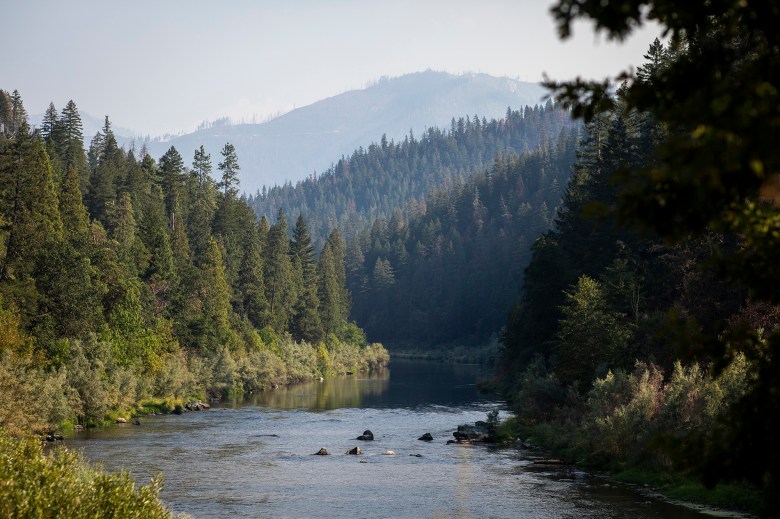
The Klamath River flows outside of Happy Camp on Aug. 29, 2022. Photo by Martin do Nascimento, CalMatters
Bauer-Kahan’s bill is one of several taking aim at the state’s byzantine, Gold Rush-era water rights system that state analysts warn has promised more water than is available. The system, which establishes priority among users, is facing mounting criticism for its history of inequality and exclusion of Native peoples and people of color.
Another bill would expand the state’s powers to curtail pumping from rivers and streams even by water users with claims that pre-date the state’s water rights law, enacted in 1914. A third would allow the board to investigate the legitimacy of senior water rights claims.
All three face opposition from builders, water providers and agriculture. So far they have cleared their houses of origin and are continuing through the Legislature.
California water watchers say it’s critical to bolster state powers to enforce water laws.
“Is the genie out of the bottle now?” Berkeley’s Kiparsky asked.
“What happens during the next drought now that it’s been very publicly demonstrated that water users can in essence treat the water board’s enforcement actions as an additional, and sometimes very modest, cost of doing business?”
###
CalMatters.org is a nonprofit, nonpartisan media venture explaining California policies and politics.


